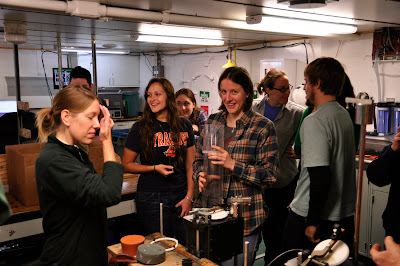After finishing several days of fueling, we finally left Punta Arenas in the afternoon to sail eastward through the Strait of Magellan towards the South Atlantic Ocean. Most of tomorrow we will be sailing south along the east coast of Tierra del Fuego, protected by its land mass from the Southern Ocean westerlies. Once we enter the Drake Passage, the place where the Pacific and the Atlantic Oceans meet and the westerlies can build seas for thousands of miles, we may expect much rougher seas.
Today has been a busy day for us. We had a megacore tutorial in the morning, led by the experienced marine technicians, Julie and Jeremy. A megacore is a sampling device that consists of twelve PVC tubes (‘cores’) that are used to collect very high quality samples of marine sediments. It is important that we learn how to remove the tubes from the megacore properly without disturbing the sediment-water interface so we could study the sediment fauna and the microbes living in the mud. As soon as we reach our research stations in the Weddell Sea, we promise to show you the photos of the megacore in action!

Megacore training (Photo by M. Cape)
Our first station will be in the Antarctic Sound, near the tip of the Antarctic Peninsula, where we pan to recover the whale-bone lander that Craig (UH Manoa) and graduate student David Honig from Duke University deployed two years ago. To make sure we are all prepared and know our tasks for sampling the fauna that colonized the whale bones, we had a meeting in the afternoon in which David and Craig familiarized us with the sampling procedure and gave us information on the science behind it. We expect to find new species of bone-eating worms and other animals that require whale bones as a habitat and food source on the seafloor.
The lander consists of a metal frame to which the whale bones are attached; it dropped to the seafloor where it remains for 1-2 yr, attracting colonization by worms, crustaceans and microbes. The whale-bone-associated fauna is very specialized to extract the organic matter out of the bones and resembles the fauna of other chemosynthetic habitats, such as cold seeps and hydrothermal vents. This system is thus suitable to explore a number of broader scientific questions. But we will come back to this in more detail once we recover the bones and the associated fauna! It appears that even after two years at the sea floor, the whale bones could “treat” us with a quit unpleasant smell, but that is not going to distract us from doing science!





No comments:
Post a Comment